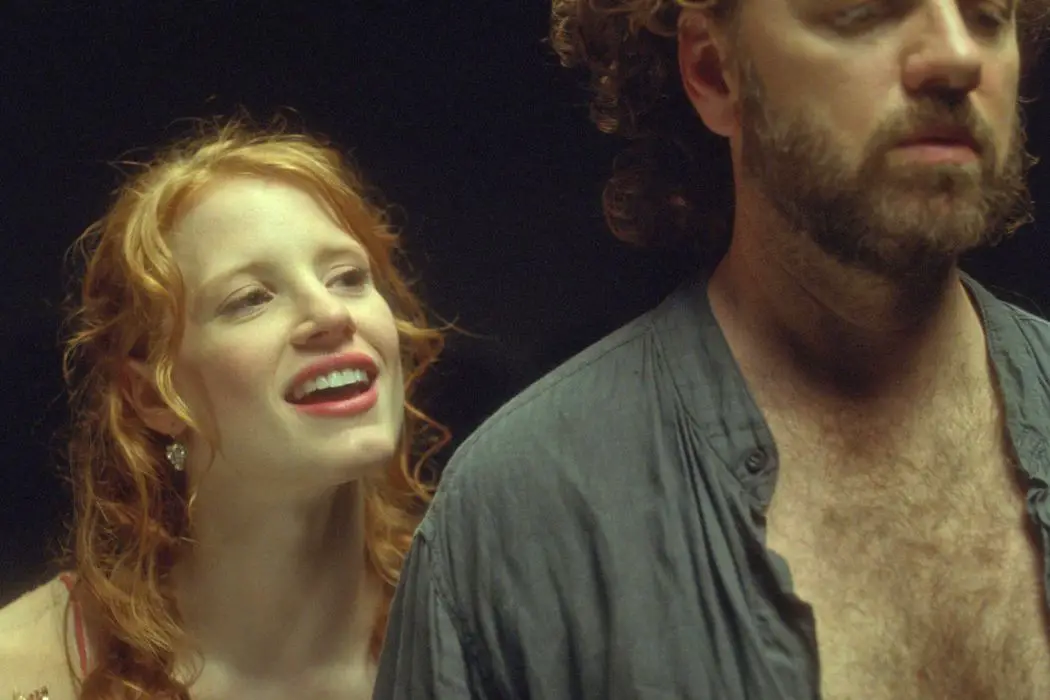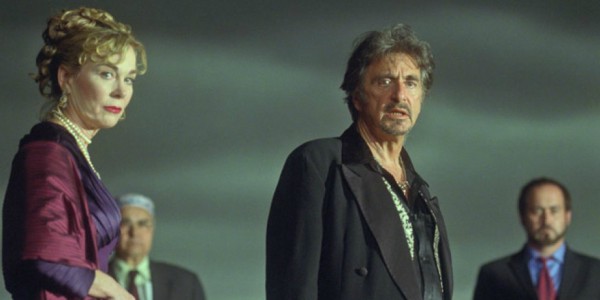WILDE SALOMÉ & SALOMÉ: Pacino’s Passion Project Finally Sees The Light Of Day

It took me a while to discover the wonderful world…
This takes some explaining, so stick with me here.
In 2006, Al Pacino and (a then unknown) Jessica Chastain starred in a production of Oscar Wilde‘s Salomé, directed by Estelle Parsons. It wasn’t a play in the conventional sense, rather a staged reading with all the actors in modern dress.
The reviews were mixed, but Pacino was utterly enamoured with the material. Whilst the stage version was still running, he decided to use the same actors in his own film of Salomé; they would shoot during the day, and perform on stage at night. As if that wasn’t enough, Pacino added a documentary into the mix, exploring both Wilde‘s life, and the making of the play and the movie.
Wilde Salomé (the documentary) and Salomé (the movie), only ever received a limited release, mainly at festivals and outside the US. At the end of March, the films will be shown for the first time in New York City, as part of a Pacino retrospective at the Quad Cinema, and will see release in Los Angeles, as well. Let’s take a closer look at both of them.
Wilde Salomé
If you’ve seen Pacino‘s 2003 documentary Looking for Richard, Wilde Salomé will feel very familiar to you. Both documentaries combine historical context and staged reenactments to fully explore their titular plays (in the case of Looking for Richard, Shakespeare’s Richard III).
The most enjoyable parts of Wilde Salomé come when we are simply following Pacino around Wildean hotspots, chiefly in Ireland and London. He’s an avuncular presence; warm, funny and literate. His European sojourns are frequently interrupted by fans and autograph hunters.
One, at the National Gallery in Ireland, jovially mimes shooting Pacino with an imaginary machine gun, à la Tony Montana in Scarface (Pacino sportingly pretends to fire back). Another asks for an autograph outside Wilde‘s London home. When asked if he knew that Wilde had lived there, the man answers in the negative, clearly more excited to be meeting Pacino than learning about Wilde.

Other moments of interest come in the troubles Pacino has in simultaneously squeezing in a play and a movie into his already busy schedule. Though he has a good relationship with Estelle Parsons, she is frustrated that Pacino isn’t dedicating enough time to her project. The poor reception of the play adds more fuel to that fire. All this backstage drama makes for an fascinating watch.
Where the documentary falls down is in the exploration of Wilde‘s history. Fans of the legendary writer won’t discover anything new about their hero; Pacino is very much coming at this from the perspective of an interested beginner. And some of the staged scenes, with Pacino as Wilde, are more than a little cringe-worthy, especially as Pacino is thirty years older than Wilde was when he died.
Despite its title, Wilde Salomé is more a documentary for admirers of Al Pacino than Oscar Wilde. If you’re fond of Al Pacino then you’ll get a lot out of this glimpse into a particularly busy time in his professional life. Enthusiasts of Oscar Wilde won’t find much here.
Salomé
Ironically, Pacino‘s movie of Salomé is more traditionally play-like than Parson‘s production was. The action is almost entirely confined to a stage; aside from a few filmed sections at the opening, the only real concession to cinema are the frequent close-ups.
If you aren’t familiar with the story of Salomé, a brief primer. Salomé is the daughter of Herodias, who is married to the Tetrarch (King Herod). The Tetrarch has been keeping Jokanaan (John the Baptist) prisoner. After coming across Jokanaan for the first time, Salomé makes an sexual advance and is rebuffed. The Tetrarch has always had a ‘thing’ for his stepdaughter, and asks her to dance for him, offering anything she desires in return. She accepts, dances, and then makes her request: the head of Jokanaan. Her stepfather reluctantly complies. Fin.

There is one reason to watch Salomé, and that is Jessica Chastain. She brings such a ferocity to the title character than you can’t tear your eyes off her. Salomé goes through quite a journey in the film’s eighty minutes. You begin feeling sorry for the young princess as she is letched over by her stepfather and spurned by Jokanaan. That pity is soon replaced by abject terror, as the rejection turns her into a ‘monstrous’ creature of revenge. Chastain is convincing playing every facet of Salomé; it isn’t at all surprising that she often credits her portrayal of the damaged young woman as launching her film career. Salomé proved that she could play anything.
Everything else about the movie is just okay. The scant staging is uninspiring, and already looks rather dated. Pacino, as the Tetrarch, only really comes to life in the concluding moments, where he has to rapidly change from desiring Salomé to being repulsed by her. Pacino himself calls Wilde‘s words ‘florid’; newcomers to play may be surprised by the sheer amount of times the moon is compared to one thing or another. Oscar Wilde sure loved himself a simile.
Salomé overall is a perfectly fine, perfectly forgettable movie. Jessica Chastain‘s performance is the only reason it’s worth seeing.
Does It Work As A Whole?
We’ve covered Wilde Salomé and Salomé individually, the question now is do they work as a double feature?
Yes and no. The recommended viewing order is Wilde Salomé and then Salomé, which makes sense. You have the documentary to give you context first, and that provides a fuller understanding of the movie; both Wilde‘s work, and the circumstances of the film’s production.

The problem is, so much of the film is excerpted in Wilde Salomé, that by the time you get on to Salomé, you have already seen the highlights. And these are no mere snippets; there are about twenty minutes of repeated material across the two films.
So unless you would consider yourself a Salomé or a Pacino obsessive, I’d recommend you just watch Wilde Salomé.
Wilde Salomé & Salomé: In Conclusion
There are two things that make Pacino‘s Salomé films work. In Wilde Salomé, it is his endearing passion for Oscar Wilde and his play. In Salomé it’s Jessica Chastain‘s magnetic, transcendent, terrifying performance.
Both films are far from perfect. Wilde Salomé only offers a very basic look into Wilde‘s life, and the staging of Salomé is distinctly uninspired. The combination of Pacino and Chastain, however, results in plenty to enjoy, however flawed the project may be.
Have you seen Wilde Salomé and/or Salomé? What did you think?
Wilde Salomé and Salomé are showing from March 30th at the Quad Cinema, NYC, as part of their ‘Pacino’s Way’ retrospective, and will open in Los Angeles on March 30. For further information, click here.
Does content like this matter to you?
Become a Member and support film journalism. Unlock access to all of Film Inquiry`s great articles. Join a community of like-minded readers who are passionate about cinema - get access to our private members Network, give back to independent filmmakers, and more.
It took me a while to discover the wonderful world of cinema, but once I did, everything just fell into place.













